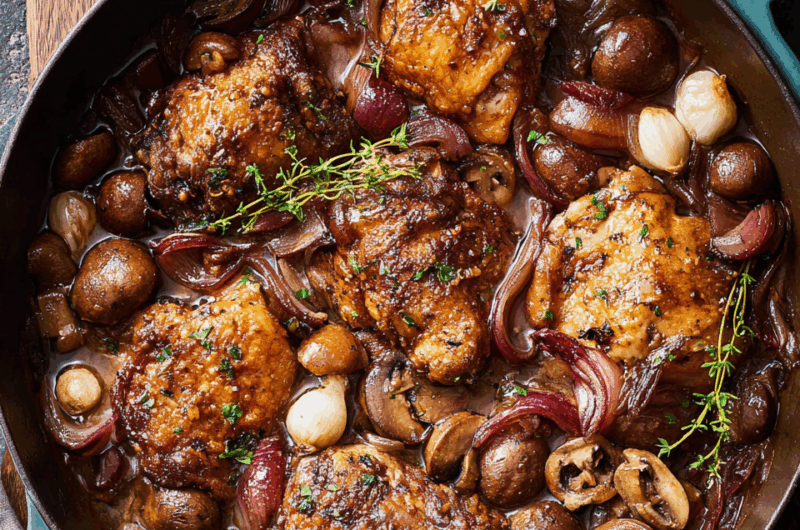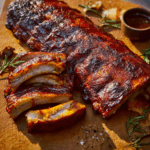The magic of Coq au Vin lies in its rich depth of flavor, achieved by slowly braising chicken in red wine with smoky bacon, earthy mushrooms, and sweet shallots. This classic French dish turns humble ingredients into a gourmet centerpiece, perfect for impressing guests or indulging in a cozy night at home.
While its origins may be rooted in traditional rural cooking, Coq au Vin is as timeless as it is versatile. Pair it with buttery mashed potatoes or a fresh baguette to soak up every last drop of sauce, and enjoy it alongside a glass of the same wine used in the pot for an authentically French dining experience.
Full Recipe:
-
6 bone-in, skin-on chicken thighs
-
Salt and freshly ground black pepper, to taste
-
6 slices thick-cut bacon, chopped
-
1 pound mushrooms, halved
-
1 large onion, chopped
-
4 shallots, halved
-
2 tablespoons all-purpose flour
-
2 tablespoons unsalted butter
-
3 cups Burgundy or Pinot Noir wine
-
4 sprigs fresh thyme
-
2 cups chicken broth
Directions:
-
Preheat oven to 350°F (175°C).
-
Pat chicken dry, then season generously with salt and pepper.
-
In a large Dutch oven over medium heat, cook bacon until crispy. Remove bacon and set aside, leaving drippings in the pan.
-
Add chicken to the bacon fat, skin side down, and brown on both sides (about 5 minutes per side). Remove chicken and set aside.
-
Add mushrooms, onion, and shallots to the pot. Sauté until caramelized, about 8–10 minutes.
-
Stir in flour and butter until vegetables are coated and the mixture is slightly thickened.
-
Return chicken and bacon to the pot. Pour in wine, add thyme, and top up with chicken broth until chicken is just covered.
-
Bring to a simmer, then transfer to oven uncovered for 30 minutes, basting chicken occasionally.
-
Remove from oven, place pot back on stovetop, and simmer uncovered for 10–15 minutes until sauce thickens to desired consistency.
-
Serve hot with mashed potatoes, crusty French bread, or egg noodles to soak up the sauce.
Prep Time: 15 minutes | Cooking Time: 1 hour 10 minutes | Total Time: 1 hour 25 minutes
Kcal: 480 kcal | Servings: 6 servings
A French Classic with Rustic Roots
Coq au Vin, which translates directly to “rooster in wine,” is one of the most iconic dishes in French cuisine. It represents the heart of rustic French cooking: transforming humble, everyday ingredients into a rich, comforting, and elegant meal. Traditionally, the dish was a way for rural families to tenderize older roosters by slow-cooking them in wine, resulting in meat that was both flavorful and tender. Over the centuries, this hearty farmhouse stew has evolved into a beloved gourmet dish, enjoyed in homes and high-end restaurants alike.
A Dish Steeped in History
Although often associated with Burgundy due to the famous wine used in its preparation, Coq au Vin is thought to have roots in various regions of France, each bringing its own spin to the recipe. In Burgundy, Pinot Noir (or Burgundy wine) is the star, but in other parts of the country, you might find white wine used instead, as in Coq au Vin Blanc. The earliest mentions of the dish date back centuries, with legends claiming it even goes as far as the time of Julius Caesar. While the truth of those stories is debatable, the fact remains that Coq au Vin has stood the test of time as a symbol of slow, intentional cooking.
Why Coq au Vin is Timeless
Coq au Vin’s enduring popularity comes from its balance of flavors and textures. The combination of poultry, smoky bacon, earthy mushrooms, caramelized onions, and fresh herbs creates a deep, layered taste experience. The red wine not only tenderizes the meat but also infuses the sauce with a luxurious richness. The dish’s slow cooking method ensures the flavors meld together beautifully, making it just as satisfying today as it was hundreds of years ago.
Regional Variations
While Burgundy’s version is the most famous, French regions have adapted Coq au Vin to suit local tastes and ingredients:
-
Coq au Vin Blanc: Made with white wine, often from Alsace, paired with cream for a lighter but still indulgent flavor.
-
Coq au Riesling: A variation from the Alsace region using Riesling wine, lending a floral and aromatic profile.
-
Coq au Champagne: Uses Champagne instead of still wine, giving the sauce a delicate sparkle and unique character.
-
Coq au Vin Jaune: A specialty from the Jura region, featuring Vin Jaune, a distinctive, nutty wine.
The Importance of Wine Selection
Wine is not just a cooking liquid in Coq au Vin—it is the backbone of the entire dish. Traditionally, a young, full-bodied Burgundy or Pinot Noir is used, as its acidity and fruitiness balance the richness of the chicken and bacon. While some chefs recommend using the same wine you plan to serve at the table, it’s not strictly necessary to buy an expensive bottle. A mid-range, drinkable wine works beautifully. The key is to avoid overly sweet wines, as they can throw off the flavor balance.
Layering Flavors
One of the secrets to an outstanding Coq au Vin lies in layering the flavors. The dish starts by rendering bacon, creating a smoky, savory base. Browning the chicken in the bacon fat adds a golden crust that locks in flavor. The vegetables—especially mushrooms, onions, and shallots—are sautéed until caramelized, releasing their natural sweetness. A touch of flour helps thicken the sauce, while the long, slow braise in wine and broth allows all the components to mingle into a rich, velvety harmony.
The Role of Herbs
Fresh thyme is a classic herb in Coq au Vin, lending its subtle, earthy aroma. Bay leaves are often added for depth, and sometimes parsley is used at the end for a pop of freshness. While you could experiment with rosemary or tarragon, staying true to thyme and bay ensures the traditional French flavor profile remains intact.
Choosing the Right Chicken
In keeping with tradition, older birds were once used, as their tougher meat could withstand long braising. Today, most home cooks use bone-in, skin-on chicken thighs for the perfect balance of flavor, moisture, and tenderness. The bone adds richness to the sauce, while the skin protects the meat during cooking. Some variations include drumsticks or even a whole chicken cut into pieces, but thighs remain the preferred cut for this dish.
Pairing with Side Dishes
Coq au Vin produces a sauce so rich and flavorful that it begs for a starch to soak it up. Popular accompaniments include:
-
Mashed Potatoes: Buttery and creamy, they complement the robust wine sauce perfectly.
-
Crusty French Bread: Essential for mopping up every drop of sauce.
-
Egg Noodles: Provide a light, tender contrast to the hearty chicken.
-
Rice or Polenta: Offer a neutral backdrop for the deep flavors.
Make-Ahead Benefits
Like many braised dishes, Coq au Vin tastes even better the next day. The extra time allows the flavors to meld and deepen. It can be made a day ahead and reheated gently, making it a perfect option for dinner parties. This also reduces stress for the host, as most of the work is done in advance.
Tips for Success
To get the most out of your Coq au Vin:
-
Pat the chicken dry before browning to ensure a crisp, golden skin.
-
Cook the vegetables patiently until they are well caramelized—this adds natural sweetness and complexity.
-
Deglaze the pot thoroughly after browning to capture all the fond (the flavorful browned bits) stuck to the bottom.
-
Don’t rush the braise—low and slow cooking ensures tender chicken and a perfectly reduced sauce.
A Dish That Encourages Gathering
Part of Coq au Vin’s charm is that it feels like a celebration dish without requiring luxury ingredients. It’s a recipe that brings people together, whether for a family Sunday dinner or a holiday gathering. The aromatic steam that rises from the pot as it simmers is enough to draw everyone into the kitchen.
Wine Pairing at the Table
While the same wine used in cooking is a safe choice for pairing, you can also experiment with wines that have complementary profiles. A medium-bodied red like Beaujolais works well, as does a Côtes du Rhône. For white wine variations, a dry Chardonnay or Alsace Pinot Gris is a great match.
Modern Adaptations
While the traditional recipe is cooked on the stovetop and in the oven, modern cooks sometimes adapt it for the slow cooker or Instant Pot. These methods shorten active cooking time while still delivering the deep, complex flavors that make Coq au Vin so beloved.
Cultural Significance
Coq au Vin is more than a dish—it’s a piece of French heritage. It embodies the principles of making the most of available resources, respecting seasonal ingredients, and taking the time to cook food slowly for maximum flavor. In an age of fast meals and shortcuts, this dish reminds us of the joy in slowing down and savoring the process.
Conclusion
Coq au Vin is a testament to the beauty of French country cooking: simple ingredients, elevated through technique and patience, into something extraordinary. From its rustic origins to its place on fine dining menus, this dish captures the essence of comfort and sophistication in one pot. Whether you stick to the traditional Burgundy version or experiment with regional variations, Coq au Vin offers a rich, satisfying dining experience that never goes out of style. And perhaps the greatest pleasure of all is gathering friends and family around the table, sharing stories, laughter, and a dish that has been cherished for generations.








